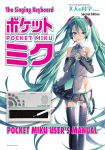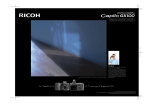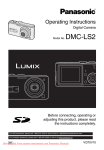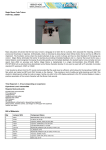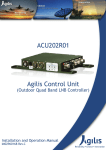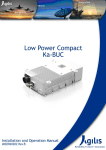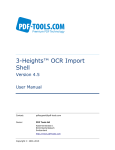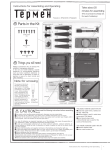Download PDF: 2.9 MB
Transcript
How to assemble the supplement Assembled Product and Part Names Built-in Amp and Speaker Mini Electric Guitar Assembly time: Approx. one hour Parts in the Kit Neck Strap ring Bridge 暗箱 Strings Body cover Coil wire Strap ring Pickup bottom plate Pickup Sticker Body * The neck cover might have been set to the neck when shipped. Please remove the neck cover before assembly. Bolts/Nuts (2 each) Tuning peg nuts (4) String anchor shaft Assembling the Body 1 Neck cover Pickup top plate Jack Speaker * When shipped, the speaker is protected by cardboard. Neck Power lamp Body Pegs 後板 Circuit board Volume dial Speaker Lead wires Jack Battery box 1.Attach the tuning shafts to the body Magnet * When shipped, the pickup top plate and the magnet are set to the body. Please remove them before assembly. 2 Assemble the tuning unit Bridges (4) Tuning shafts (4) Pick Face the side with the square protrusion up and insert the tuning shafts firmly from the outside. Attach the neck Turn the neck and body over and attach the body to the neck from above. Fasten the neck side (a) only with a bolt and nut. At this point, there is no need to tighten the bolt and nut firmly. Bolt Strings (4) Tuning peg knobs (4) Things you will need Screwdriver; cellophane tape; rubber bands; scissors; two new AA alkaline batteries or two zinc-carbon batteries. (* NiCd and other rechargeable batteries have low voltage. Therefore the guitar may not work when these batteries are used. Oxyride batteries have high voltage. Using these batteries may break the circuit.) CAUTION Please be sure to read the following instructions before assembling this kit. ● Take necessary caution when handling parts with pointed edges. There is a risk of injury. ● This kit includes screws and other small parts. Be careful not to swallow them. There is a risk of suffocation. Two AA batteries are used. Incorrect use of the batteries may cause the generation of heat, explosions or liquid leakage. The following precautions should be taken. ● Do not use rechargeable batteries such as NiCd batteries, or Oxyride batteries ● Ensure that the positive and negative terminals of the batteries are aligned correctly. ● If liquid that leaked from batteries gets into your eyes, rinse it well with plenty of water and consult a doctor immediately. If liquid leaks onto your skin or clothes, immediately wash it off. ● Always remove the batteries after use. ● Do not mix old and new batteries. ● Store the kit in a location out of the reach of small children. * Please read the instructions and cautions thoroughly before use. * For your safety, be sure to follow the instructions and cautions in this manual. In addition, do not use any parts that have become damaged or deformed during use. Volume dial Washer head screw Screw (large) Screw (medium) Screw (small) * Left over screws are spares. If the tuning shaft cannot be inserted properly, try pressing the shaft in while rocking it left and right. Notes for tightening screws Tuning shafts When tightening screws, firmly press the screwdriver straight against the screw and turn. It is said that 70 percent of the force applied is used for pushing against the screw and 30 percent for turning it. The types of screws used for the supplement are those that carve grooves into the plastic as they are inserted (self-threading). For this reason, the screw hole may be damaged if you exert too much force when tightening the screw. Since it is difficulty to turn a precision screwdriver, please use a small driver that has a grip radius of about 2 cm. (a) CAUTION Nut Although it may protrude slightly from the body, this is not a problem. Protrusion 7 to 10 mm Make sure that 7 to 10 mm of the tuning shaft sticking out. 3 Attach the strings 1.Temporarily insert the washer head screws into the back of the neck. Leave about 2 mm of the head protruding. Full scale image of screwdriver ● Materials used in this kit Body (black), neck (white): GPPS Tuning shaft, bridges (black): POM Body cover, neck cover, pickup, tuning peg knobs, volume dial, strap ring, pick (black): ABS resin Strings: Stee String end pins: Brass Screws, bolts, nuts (black): Iron Battery contacts, string anchor shaft: Iron (nickel plated) Coil wire: Copper (polyurethane leads) 2.Attach the tuning peg knobs Attach the tuning peg nuts to the tuning peg knobs. Then attach them to the tuning shafts by turning the knob. Make adjustments so that the wings of the knob are the same h e i g ht a s t h e t u n i n g shaft. CAUTION Tuning peg nut Tu n i n g p e g knob Temporarily insert the washer head screws Wings of the knob * Please dispose of this product in accordance with local regulations. Tuning shaft 1 Otona no Kagaku 2 2.Slide the strings onto the string anchor shaft 3.Secure the string anchor shaft 5. Attach the bridges 3.Attach the jack Unwind the strings leaving the piece of paper bundling them. Once you have unwound the strings, remove the paper. Slide the rings on the tips of the strings onto the shaft to attach the strings in order of thickness. Insert the string anchor shaft into the groove in the neck. Pass the bolt over the strings while holding the strings and string anchor shaft. Secure it with a bolt and nut. Attach the bridges and lay the strings in the grooves in the center of the bridges. Turn the pegs and adjust the string tension so that they are relatively tight (be careful not to overtighten the strings). If it is difficult to attach the bridge because the strings are too tight, loosen the strings slightly. Remove the nut and washer attached to the jack. Then, pass the jack through the hole for the jack in the body cover and secure it with the nut and washer removed. Jack String anchor shaft (Note the direction in which it is attached) Neck CAUTION Strings Face the raised side of the bridge towards the neck and place it on the closest position to the neck. Remove the paper bundling the strings soon after unwinding the strings. Nut Washer CAUTION Bridge Take caution not to injure hands or face with the tips of the strings. Store the green and purple lead wires close to the speaker. Lay the strings in the grooves in the center of the bridges. 4. Connect the power connector Plug in the power connector to the circuit board. (Plug it in firmly.) Bolt Power connector Separate the strings so that there are two on each side of the protrusion. Thin Body cover CAUTION String anchor shaft Red Thick Nut 4 4.Attach the strings (1) Pass the strings through the holes on the tuning shafts to the front of the body. (2) Along the protrusions, (3) pass the strings through the groove at the top of the neck and pull. (4) Then, wrap the strings clockwise one and a half times around the washer head screws that were temporarily inserted in step 1, and secure the strings with the washer head screws. CAUTION ④ Assemble the electrical components 1.Attach the volume dial Align the volume dial hole and place the volume dial onto the volume dial protrusion on the circuit board and fasten it to the circuit board with the screw (small). Approximately 5 to 6 cm of excess string may be left and the rest can be cut off using tools such as a wire cutter. Take caution not to cause any injuries with the excess strings. * Note the direction of the connector 5.Mount the circuit board Adjust the position of the circuit board so that the volume dial and the power lamp protrude from the holes in the side of the body cover. Secure the circuit board with the screws (medium). Screws (medium) Circuit board Screw (small) ③ Volume dial Circuit board ① Strings should lie in the groove guides Body cover Wrap the string clockwise around the washer head screw. Circuit board volume CAUTION Attach the strings so that they are parallel to the neck and adjust them so that the width of spaces between the strings is even. 2.Attach the speaker to the body cover CAUTION String should be in the groove ② Width of spaces is even Protrusion Parallel CAUTION Secure the speaker with washer head screws. The speaker may become tilted if the screw is overtightened. Do not secure the speaker while it is tilted. If this happens, loosen the washer head screw half a turn. Washer head screws The side with the transparent cone should face up. Try not to touch the cone. Speaker It becomes easier to secure the speaker if the washer head screws have been passed through the screw holes on the rubber part of the speaker beforehand. Parallel (d) Body cover 3 Otona no Kagaku (c) (b) When seen from the front, each string should lie against the protrusions as shown in the figure. Repeat steps (1) to (4) and attach all strings. ● Store the black lead wire of the jack in the space to the right of the jack as shown below (a) and the green and purple lead wires in the space between the jack and the speaker (b). ● Make sure that the black earth wire (c) as well as the red and black lead wires of the circuit board extend out from the top side of the circuit board. CAUTION (a) ● If it is difficult to turn the volume dial, the lead wires may be in contact with it. Properly store the lead wires again. 4 5 5.Bundle the coil and lead wires Assemble the pickup CAUTION 1.Combine the top and bottom plates of the pickup ● Do not cut off the silver parts on each of the coil wire. Doing so will cause current to stop flowing through the wire and the speaker to stop producing sound. 8. Install the pickup to the body 11.Mount the body cover onto the body Insert the pickup in from the side, below the strings, and attach it to the body from behind using the washer head screws. Mount the body cover onto the body and secure it with the screws (large). Screws (large) Pickup Press the top and bottom plates of the pickup together until they click into place. Retighten the bolts and nuts. Pickup bottom plate Bundle each end of the coil wire and lead wires by twisting them together. Fasten one end of both the coil and lead wires with cellophane tape, twist them together and then bundle them again with cellophane tape. Front Either the red or black lead wires can be bundled. Earth wire Tw i s t t h e l e a d w i re s together beforehand as shown below. Lead wires of the pickup Washer head screw Pickup top plate 2.Pass the coil wire through the hole in the pickup bottom plate Pass the coil wire through the pickup bottom plate. At this point, pull about 5 cm of the coil wire through and affix it with cellophane tape. Lead wires Cellophane tape Lead wires Back Wind the coil wire and lead wires that have been bundled together with cellophane tape around the pickup. Excess coil wire should be folded and wound around the pickup. CAUTION Pull about 5 cm of the coil wire through. CAUTION Pass the lead wires of the pickup to the back from between the body and the endmost string. 9.Connect the lead wires and earth wire Do not wind this part around the pickup. 3.Wind the coil wire Wind the entire length of the coil wire around the pickup CAUTION ● Try not to leave any slack in the coil wire when winding it. ● Be careful as pulling the coil wire too tight will break it. ● The coil wire can be wound around in either direction. 6.Cover the coil wire and lead wires 12.Attach the strap ring Attach the strap ring to the position shown below and secure it with the washer head screws. Washer head screws Connect the lead wires that have been passed through to the back to the connector for the lead wires on the circuit board. In addition, after slightly loosening the screw (a) on the back of the neck which fastens the second thinnest string, attach the earth wire on the circuit board to the screw (a) and re-tighten the screw (a). Strap ring (a) Cover the coil wire and lead wires with rubber bands or a thinly cut piece of cellophane tape. Rubber band Ensure that the lead wires of the pickup do not come off. Lead wires Cellophane tape or craft tape((3 to 5 mm width) Earth wire If the strap ring cannot be slid around, try again after loosening the screws securing the neck to the body. Screw (large) CAUTION After attaching the strap ring, observe the guitar from the side to make sure that the neck and body are attached together evenly. If the neck is not straight, loosen the two bolts, straighten the neck and retighten the bolts. 7.Insert the magnet into the pickup top plate Insert the magnet into the top plate of the pickup and affix the provided sticker on top. Temporarily attach the pickup to the body using the screw (large) and wind the coil wire. (Remove the pickup when finished.) Grip the neck and wind the coil wire around the pickup. Use the hand holding the coil wire to s t ra i g hte n t h e w i re w h i l e winding. 10.Attach the neck cover Attach the neck cover to the neck and secure it with washer head screws in three locations. Sticker Washer head screws Magnet 4. Bundle the coil wire Pass the end of the coil wire through the hole in the pickup bottom plate and through the other hole (a), remove the cellophane tape, and pass the other end of the coil wire through the first hole (b). Neck cover Finished! (a) 5 Otona no Kagaku (b) CAUTION Be careful not to pinch the strings when tightening the screws. 6 Let's make some noise 3 Insert the batteries and turn the power on 1 Insert the batteries into the battery box and turn the volume dial to ON. The power lamp lights when the power is on. You can adjust the volume with the volume dial. After you have actually made some sound, try changing the spacing between the strings or the position of the pickup. You may find a difference in ease of play and in the sound. Try moving them around until you find positions that you like. Loosen the screws securing the pickup before adjusting the position of the pickup. Volume dial Power lamp 2 Let's adjust each part Let's tune If you have a musical instrument nearby, tune the guitar using the scales of the instrument. Turn the pegs to adjust the tension of the strings until getting the desired pitch. When you turn the pegs, you are increasing the tension in the strings from loose to tense. The pitch will gradually increase while you are turning the pegs. Stop turning when you have reached the desired pitch. If you have tuned too high, turn the pegs to reduce the tension in the strings and start tuning again. Because the tension in a string changes during tuning, it may affect the other strings. Since the tuning of one string will affect that of the others and may change their pitch, once you have finished tuning all four strings, start again from the thickest string. D G B E How to change strings Change a string if it has broken or become String gauges (inch) worn. Use strings for electric guitars. We 1st String .009 to .010 recommend the string gauges to the right. To 2nd String .011 to .013 change the string, (1) turn the pegs so that there is no tension remaining in any of the 3rd String .016 to .017 strings. (2) Remove the strap ring, neck cover 4th String .024 to .026 and body cover. (3) Remove the washer head screw on the back of the neck that is securing the string to be changed. (4) Remove the bolt securing the string anchor shaft. (5) Pull and lift up the string anchor shaft and remove the string from the shaft. (6) Pass the new string through the shaft and retighten the string. For lowe For higher E E B G D B G 1 Q&A 2 3 4 5 The pitch of each string is as shown to the left. Pitches that are connected with arrows are the same pitch. Therefore, if you tune one string, you can use that string to tune the other strings as well. If you do not have any musical instruments nearby, the pitch for the dial tone when you pick up the phone is “G”. You may find it useful to tune the 3rd string with this pitch. Q: The coil wire has broken. Q: Turning the tuning peg does not cause the pitch to rise. A: Join the two broken ends and continue winding. The coil wire has a transparent coating and this should be removed using sandpaper or the like. Following this, ensure that the strands are well wrapped around each other. A: The initial string tension may be insufficient. Remove the neck cover, loosen the washer head screw securing the string in question, increase the tension in the string, and then retighten the screw. A: Note that excessive tightening of the tuning peg can damage the threads on the tuning shaft. If this has occurred, remove the string in question, move the peg lug to a position beyond the damaged threads, and then tighten the string. Q: The guitar does not produce any sound when turned on. A: Confirm that the batteries are new and that they have been inserted in the correct direction. A: Ensure that the pickup and battery connectors have been securely fastened in place. Q: Increasing the volume has little effect. A: Ensure that the speaker is facing the correct direction. (The transparent cone should be facing outward.) A: Indentation of the transparent speaker cone can also cause the volume to stay low. 7 Otona no Kagaku Q: The guitar cannot be tuned properly. A: Check whether the bridge has become detached or is angled incorrectly.





